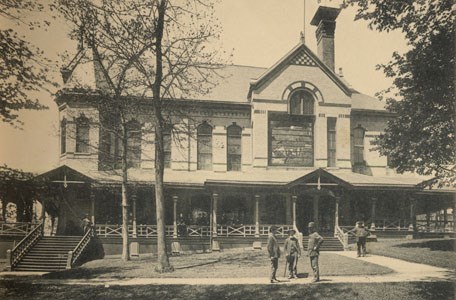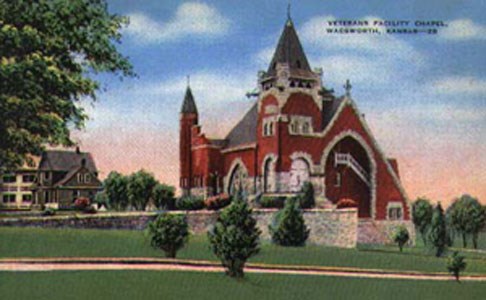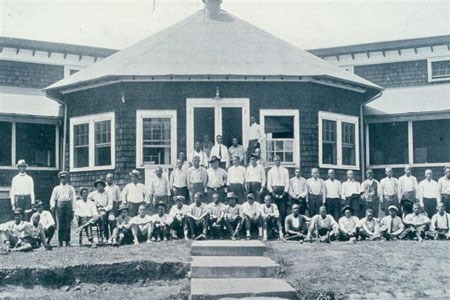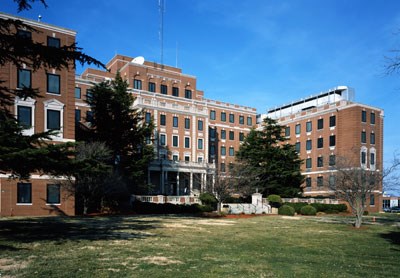Last updated: November 14, 2017
Article
History of the National Home for Disabled Volunteer Soldiers

After the American Revolutionary War, the Federal Government paid pensions to those veterans who had service related injuries. The government expanded this pension system in 1818 to include any veteran who needed assistance, making clear that the pension was a reward for service, not a charity. In 1833, as a result of heightened demand, Congress created the Bureau of Pensions to administer these benefits. Congress passed the General Pension Law in 1862 to make benefits available to Civil War veterans who had service related injuries or disease.
Established in 1811, the first institution in the United States for servicemen was the U.S. Naval Asylum in Philadelphia. In 1851, the U.S. Soldiers Home in Washington, DC opened for men with service related disabilities or men who had at least 20 years of service. To be eligible for these homes, a soldier paid into the system through pay deductions over the course of his career.
National Home for Disabled Volunteer Soldiers
Charitable organizations and concerned citizens had long recognized the need for a place to care for disabled veterans. The injured and debilitated men who returned home from the Civil War needed long term care, often more than their families could offer. As volunteers, they were not eligible for care in the homes serving career military veterans. Even though these veterans were eligible for pensions, it was not always enough to help them cope with their injuries or chronic illnesses. Many people believed that creating a home for veterans was the best way to care for these disabled men.
Legislation for the creation of the National Asylum of Disabled Volunteer Soldiers was introduced to Congress on February 28, 1865. Both Houses of Congress quickly passed the legislation, and President Lincoln signed the bill in March 1865, just a month before his assassination. In 1873, the name was changed from National Asylum of Disabled Volunteer Soldiers to the National Home for Disabled Volunteer Soldiers, to remove any stigma attached to the term "asylum."
As described by the Board of Managers, “the Home is neither an [sic] hospital nor alms-house, but a home, where subsistence, quarters, clothing, religious instruction, employment when possible, and amusements are provided by the Government of the United States. The provision is not a charity, but is a reward to the brave and deserving.” The Board of Managers envisioned a system of branches located across the country. The Federal Government built three branches within the first year, and the system grew to 11 National Home branches by 1929.

1881 Souvenir book of the Northwestern Branch
Soldiers like?
The ideas and designs of men like Frederick Law Olmsted and Andrew Jackson Downing influenced the design of the National Home branches, most of which date from the era of grand campus design. The National Home branches had large campuses, generally more than 100 acres each, far enough away from the closest town to keep the veterans away from vices. The National Home branches offered a wide array of architectural styles including Richardsonian Romanesque, Queen Anne, and Stick styles. Each National Home branch contained barracks, a dining hall, a hospital, a cemetery, and recreational facilities. The types of recreational facilities offered included beer halls, parks, lakes, zoos, theaters, and libraries. In addition to recreational opportunities, the men could work during the day to make additional money. Most of the branches had farms that employed the members and provided food for them to eat. Other branches offered jobs such as working in a shoe factory or at a printing press. The National Home branches were regulated by a military structure. Originally, the men at the National Home for Disabled Volunteer Soldiers were called inmates, but by the 1880s, the term was no longer in use. The residents were known as members, soldiers, men, and beneficiaries (member will be used throughout the itinerary).
National Cemeteries
The high number of casualties of the Civil War created a need for military burial space. In 1861, the first military cemetery opened at the U.S. Soldiers Home, in Washington, DC. In 1862 Congress created a more permanent solution, authorizing the president to buy land for cemeteries. President Lincoln created 14 cemeteries in 1862 and subsequent presidents created an additional 59 by 1870. Most of these cemeteries were near battlefields, campgrounds, and hospitals. The 1867 Act to Establish and Protect National Cemeteries directed the secretary of war to enclose cemeteries “with a good and substantial stone or iron fence” and mark every grave with a small headstone or block. An 1873 law authorized money to pay for headstones, which were to be white marble or granite 4 inches thick, 10 inches wide, and 12 inches long. This law also made every honorably discharged veteran eligible for a burial. All 11 National Home branches had a National Cemetery either on the campus or in the surrounding community. In the 1930’s, cemeteries were created in metropolitan areas to allow veterans to be buried near where they had resided. In 1973, these National Cemeteries were transferred from the Department of the Army to the Veterans Administration.

Courtesy of the VA virtual museum
A 12-member Board of Managers ran the National Home for Disabled Volunteer Soldiers and included, as ex-officio members, the president, secretary of war, and the chief justice. Congress appointed the remaining nine members. The board was responsible for establishing the branches, inspecting the sites, monitoring the finances, and reporting to Congress annually.
Initially the National Home for Disabled Volunteer Soldiers received funds appropriated from fines against officers and soldiers. As the system grew, the Board of Managers needed a more consistent source of income, so in 1875, Congress began using appropriated funds to support the National Home for Disabled Volunteer Soldiers.
Development of each of the National Home branches
The first branch, the Eastern Branch, in Togus, Maine, opened November 10, 1866, on the site of a former resort that went bankrupt during the Civil War. The board selected this site because the buildings were already in place, which allowed the branch to open quickly. Soon after, the Board of Managers opened the Northwestern and Central Branches in Milwaukee, Wisconsin and Dayton, Ohio, respectively. The board managed the creation of the Northwestern and Central Branches from land purchase through building construction. These branches exemplify the campus design of the National Home branches.
The Southern Branch in Hampton, Virginia opened in 1870. The board wanted a branch in the South to serve African American veterans from the United States Colored Troops, but few actually entered the Home. The location was quite popular with other veterans though because of the mild climate. In 1885, the Western Branch, in Leavenworth, Kansas, was the first branch to open west of the Mississippi River. This new branch responded to a change in policy that allowed veterans with non-service related disabilities to be members at National Home branches. Continuing to create western branches, the board opened the Pacific Branch in Santa Monica, California, in 1888.
The Board of Managers built the Marion, Indiana and Danville, Illinois branches in response to a growing need for space as a result of increased membership at the National Home branches. Constructed in 1888, the Marion Branch was the last one built in the Picturesque style. The board opened the Danville Branch in 1898. A Tennessee senator’s argument that much of eastern Tennessee opposed secession and provided a significant number of volunteers for the Union convinced the Board of Managers to open another southern branch. The board also believed that the southern climate would be beneficial for men with respiratory conditions, who would be more comfortable in the milder climate and low humidity. The newly created Mountain Branch in Johnson City, Tennessee admitted its first members in 1903. The 1893 Columbian Exposition in Chicago influenced the design of its Beaux Arts style grounds and architecture, moving away from the Picturesque style to a more formal, grid-like campus.
The Board of Managers built the Battle Mountain Sanitarium in Hot Springs, South Dakota, in 1902 as the only National Home branch established as a medical, rather than residential facility. This branch specialized in gastrointestinal and respiratory conditions as well as skin diseases. Men stayed only as long as they benefited from the treatments, after which they could return to another branch or leave the National Home for Disabled Volunteer Soldiers system entirely. The location was hard to get to, so not as many veterans went there as expected. First established in 1876 as the New York State Soldiers’ and Sailors’ Home, the final branch was in Bath, New York. The Board of Managers acquired the site in 1929 to accommodate the increasing number of members after World War I. The site was advantageous because no new construction was required, and it was already operational.

Courtesy of Mountain Home VA Medical Center
The National Home for Disabled Volunteer Soldiers was initially open to any Union soldier who could prove a connection between service and his injury. Congress loosened the eligibility requirements for the National Home branches in 1871 to include veterans of the War of 1812 and Mexican War, so long as they did not fight against the Union in the Civil War. In 1884, membership at the National Home branches was expanded again to include any honorably discharged soldier or sailor, who could not support himself due to a disability. The disability did not have to be a service related injury. In 1900, Spanish American War veterans became eligible. Despite these increases in membership, the branches continued to see a decline in population as aging Civil War veterans died.
Confederate veterans were never allowed at the National Home branches, but several southern States established similar homes which were funded and managed by either State governments or private organizations. These homes were closed by the 1950’s when the last Civil War veterans died.
African American soldiers were allowed membership at the National Home branches, which established a policy of racial equality; in the decades following the Civil War the level of equality became less and less. While African Americans were at the same facility and received the same benefits, they were segregated within the facility and slept in separate barracks and ate at different tables. Few African Americans took advantage of the opportunity even though 10 percent of the Union Army was African American. By 1900, only two and a half percent of the members at the National Home branches were African American. The Hampton branch in Virginia was designed to encourage African American members, but it was not successful because not that many more African Americans went there.
World War I dramatically increased the population of the National Home branches, though this new population had different needs. The World War I veterans were primarily younger men who needed short term medical care or help with psychiatric problems. After World War I, women veterans entered the National Home branches in low numbers. The Danville Branch built a barracks for women, but in 1924, less than half a dozen women were there. In 1928, membership was extended to women who were nurses.

Hampton, Virginia from 1933
Photo by James Rosenthal, Historic American Buildings Survey photographer
The Southern Branch was transformed into a medical hospital during World War I. The influx of veterans after World War I and the differing needs of the newer veterans put a strain on the existing veteran care medical facilities. The National Home branches transitioned into hospitals and medical facilities to care for the World War I soldiers and veterans. When President Hoover signed Executive Order 5398 on July 21, 1930 to create the Veterans Administration (the VA), the order abolished the National Home for Disabled Volunteer Soldiers and its Board of Managers; at that time the National Home branches were reorganized as the Bureau of National Homes within the VA. In 1989, the Veterans Administration was elevated to Cabinet status and renamed the Department of Veterans Affairs. The transition from permanent homes to short term medical care is reflected in the architectural changes at the National Home branches. After the creation of the Veterans Administration, building and campus design became more standardized. Over the years, the VA has continued to improve facilities to serve the changing needs of veterans; however, the unique campuses and architecture of the original National Home branches remain, providing insight for visitors as to how the Federal Government cared for and continues to provide for veterans.
